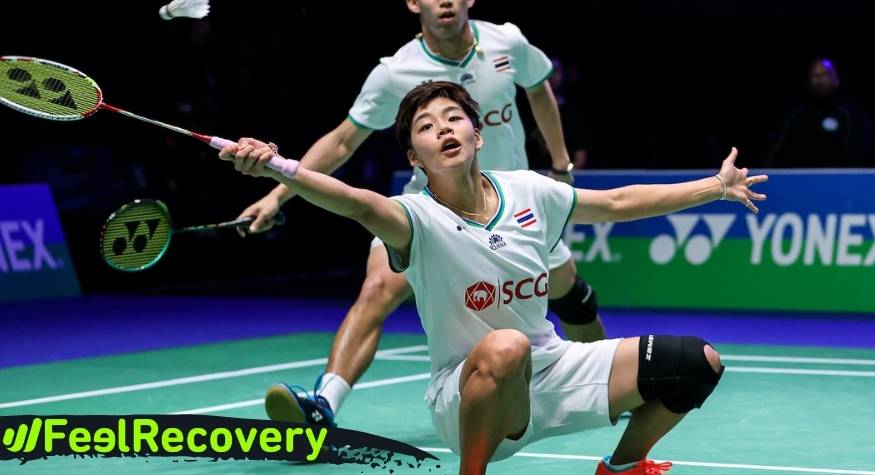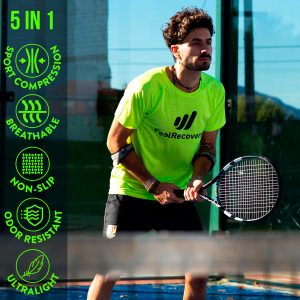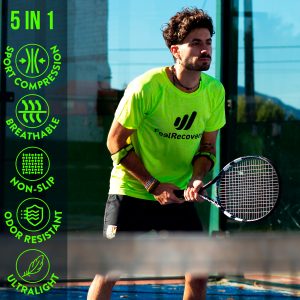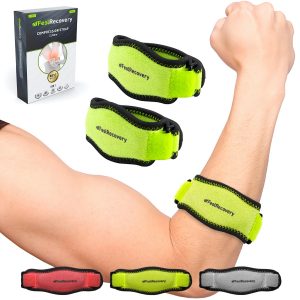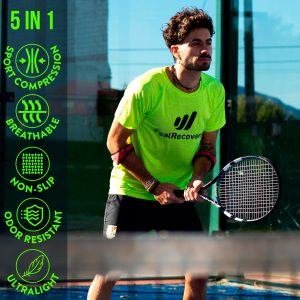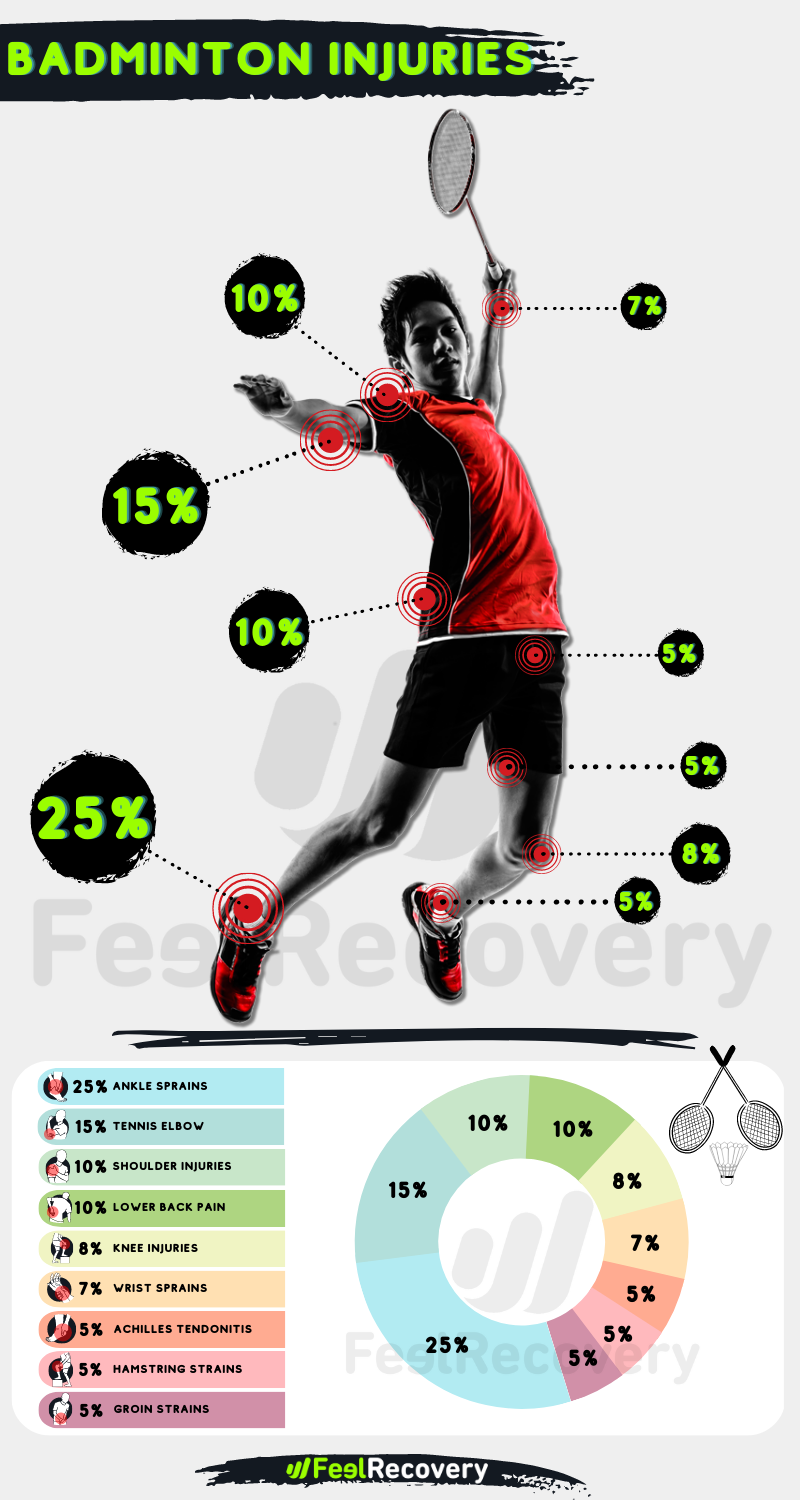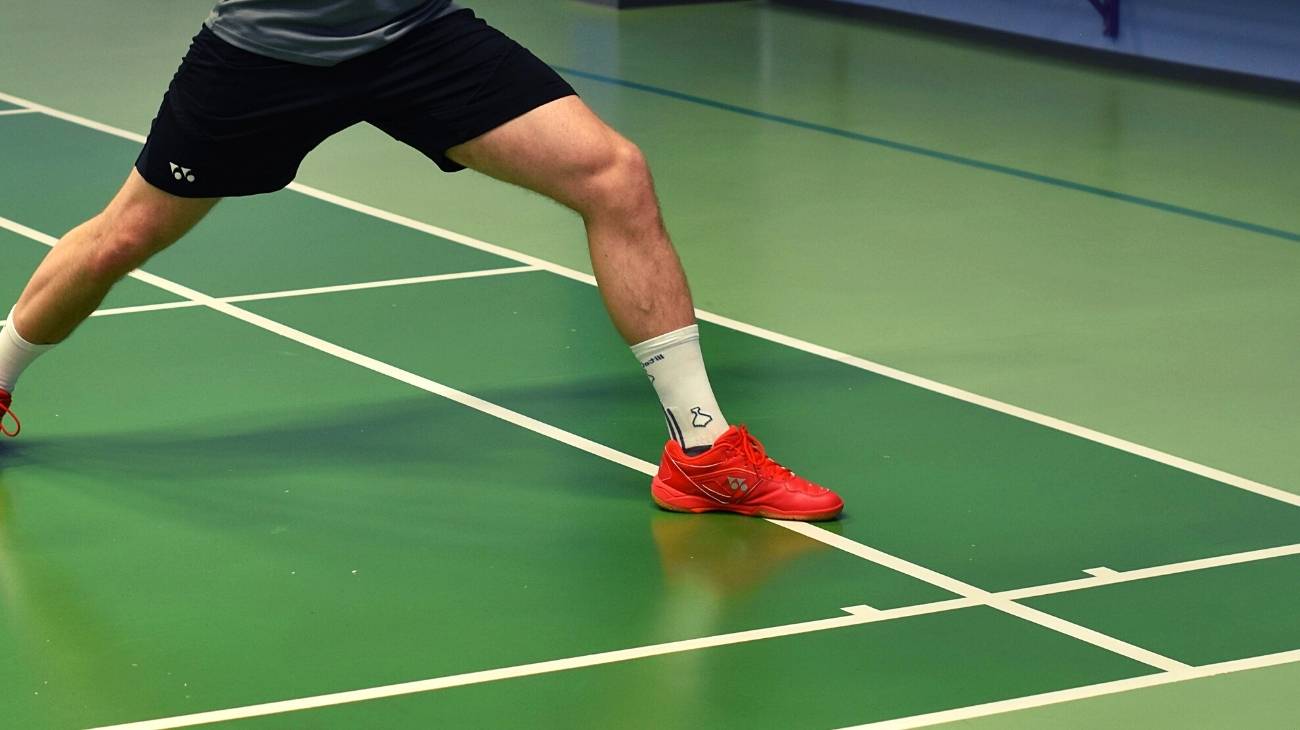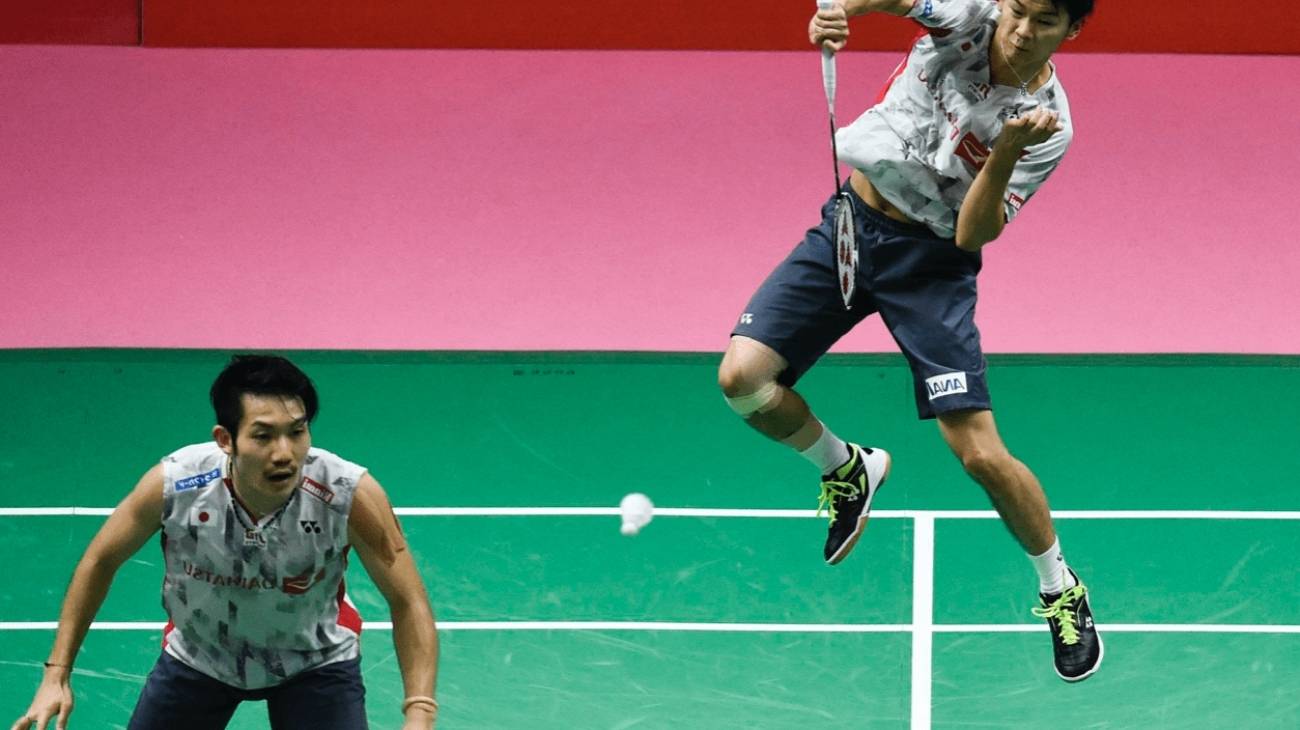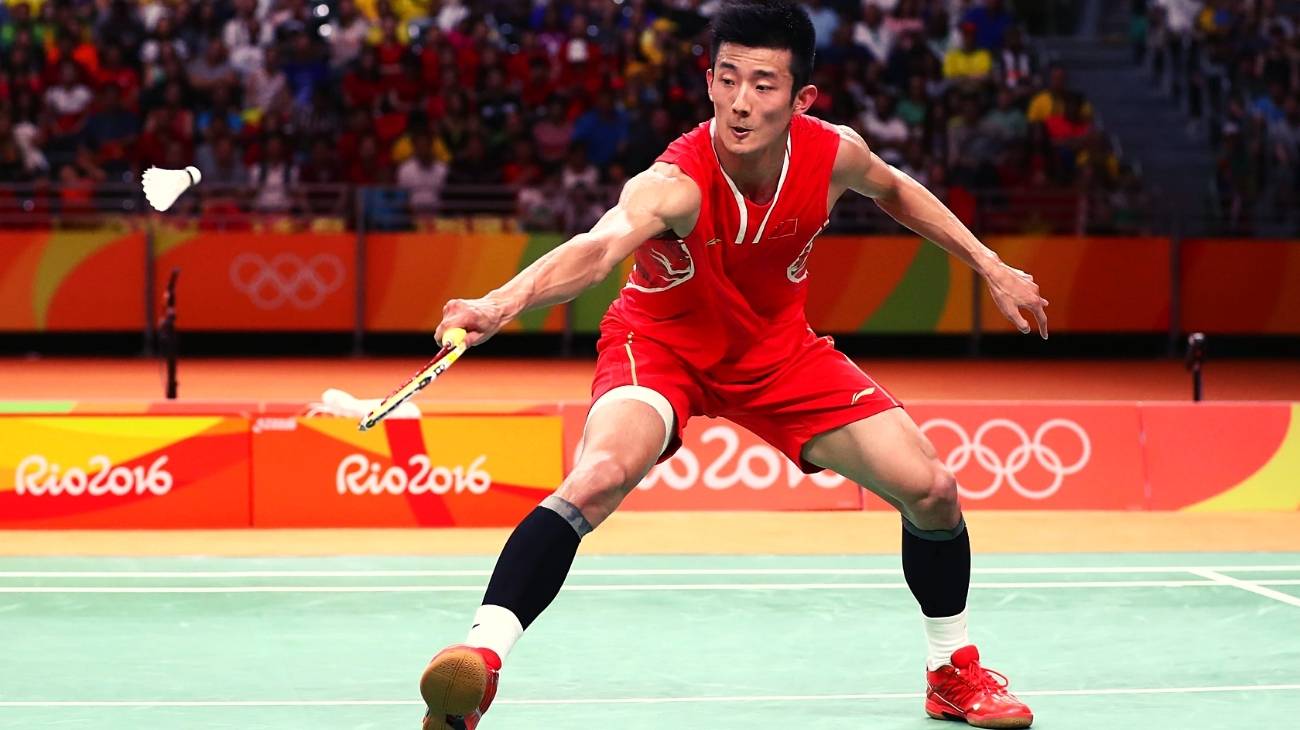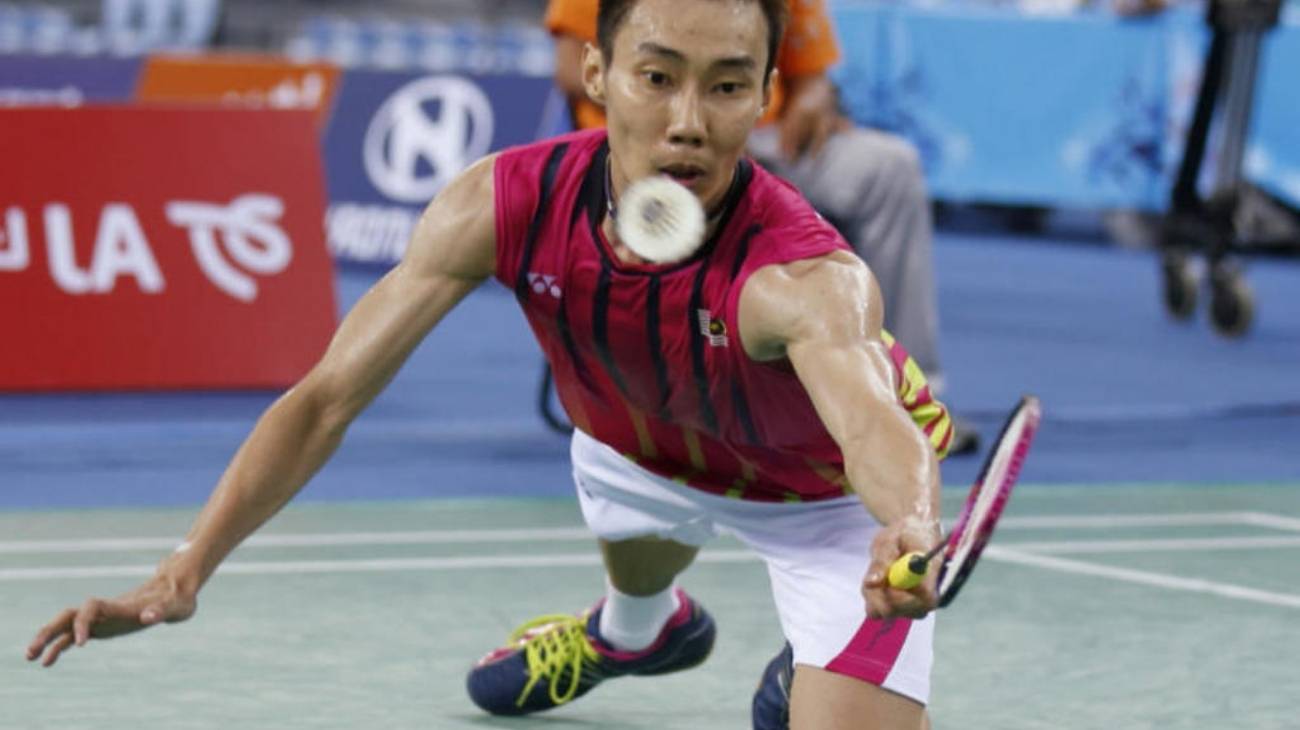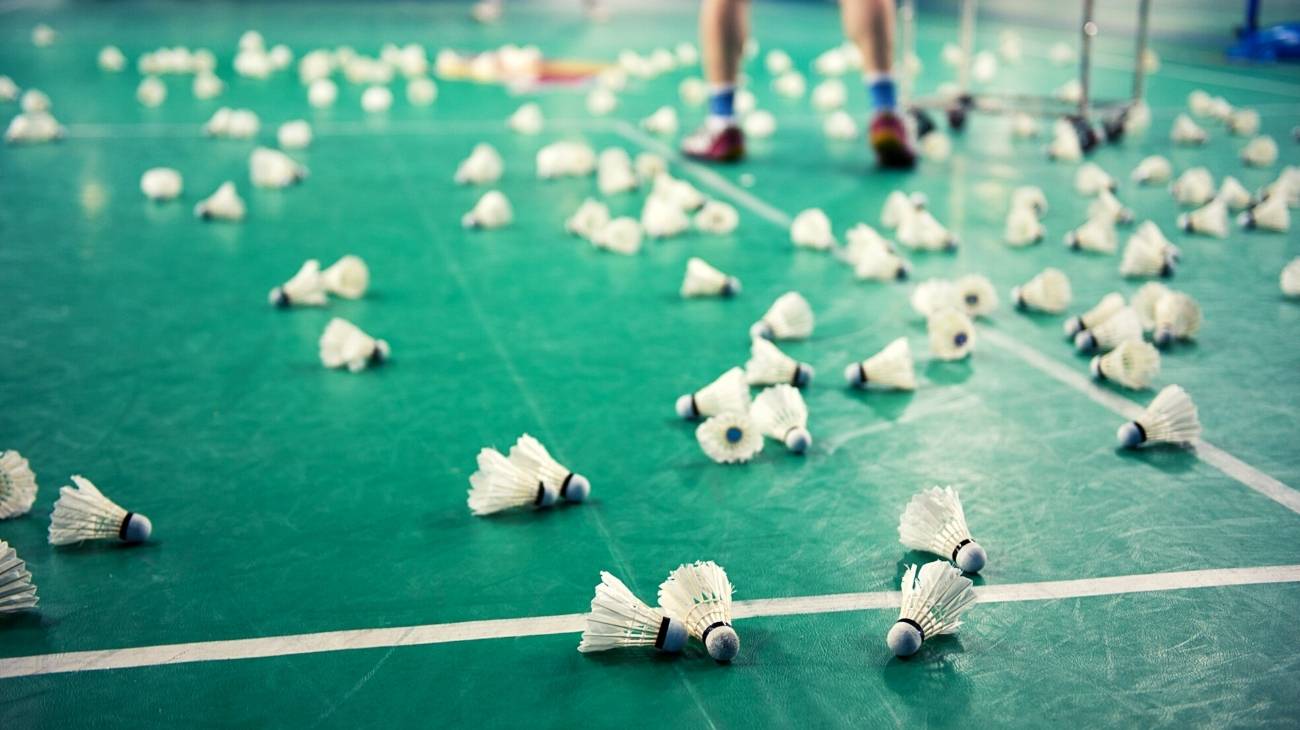Unlike tennis, in badminton the player travels on average 4 miles in a shorter playing time. Such wear and tear makes it much easier to suffer injuries to any part of the body.
In this article we are going to show you the most effective treatments used to treat all types of badminton injuries, as well as indications on how to apply the first aid of the RICE therapy.
What are the most common types of injuries when playing badminton?
The back, arms and legs are the most at risk areas for a badminton player, but the chances of getting injured in a match are low compared to other racket sports.
Check out this list of the most common types of injuries in badminton, the world's fastest Olympic and racket sport:
- Low back strain: the clinical term is lumbago and is a pain in the lower back. When this area is injured there is an increase in muscle stiffness. Although it is important to be fit, this injury can occur in athletes of any age.
- Tendonitis: the fibrous structure that attaches the muscle to the bone is one of the most affected in both knees and ankles. It is an inflammation that generates severe pain and will require us to stop the activity immediately. It has a high recurrence rate, so recovery from a tendon injury must be complete before attempting to return to the court.
- Epicondylitis: This is a very common injury in racket sports, especially tennis and badminton. It is caused by repetitive movements with moderate force. The pain is intense at the time, but usually increases hours after the injury if proper attention is not given.
- Sprains: when there is an increase in the demands of training, it can occur without warning. It is an injury to one or more joint ligaments, mainly in the knees and ankles. Bending and twisting of the body are the main causes of lower limb sprains, when the foot is fixed to the ground. Blows during play or training also cause strong movement in the knee and ankle.
- Achillestendon rupture is a serious injury that occurs when the tendon connecting the calf muscles to the heel ruptures completely. Common symptoms include sharp pain at the base of the calf, swelling in the area of the rupture and inability to stand on tiptoe, the latter being the main sign that it is not a minor injury such as a bruise or sprain.
- Flatfoot: known as "arch drop", occurs when the entire sole of the foot touches the ground when standing. This may be due to poor development of the muscles that make up the arch of the foot, which are: peroneus lateralis brevis, peroneus lateralis longus, fifth toe abductor, posterior tibialis, flexor hallucis longus and abductor hallucis toe.
- Plantar fasciitis: this is inflammation of the fascia of the foot, which causes a lot of pain and limits walking mobility. Its most common cause is overuse of this part of the body when playing sports such as badminton.
- Fractures: although they are not common in badminton as there is little chance of suffering a strong blow to a bone, as in any sport, the possibility is latent. A fracture occurs when a muscle receives a blow or is forced in an aggressive way and causes it to crack. This causes a lot of pain, swelling and in some cases limits the mobility of the affected limb.
Best products for badminton injury recovery
Bestseller
-
2 Ankle Compression Sleeve (Green/Navy)
£20,95 -
2 Elbow Compression Sleeve (Black/Gray)
£20,95 -
2 Elbow Compression Sleeve (Green/Navy)
£20,95 -
2 Elbow Compression Sleeve (Pink/Bordeaux)
£20,95 -
2 Knee Compression Sleeve (Black/Gray)
£20,95 -
2 Knee Compression Sleeve (Green/Navy)
£20,95 -
2 Knee Compression Sleeve (Pink/Bordeaux)
£20,95 -
2 Thigh Compression Sleeve (Black/Gray)
£20,95 -
2 Thigh Compression Sleeve (Green/Navy)
£20,95 -
2 Thigh Compression Sleeve (Pink/Bordeaux)
£20,95 -
Microwaveable Wheat Bag for Pain Relief (Hearts)
£20,95 -
Microwaveable Wheat Bag for Pain Relief (Oxford)
£20,95 -
Microwaveable Wheat Bag for Pain Relief (Sport)
£20,95 -
Wheat Bag for Microwave Classic Bottle Shaped (Hearts)
£20,95 -
Wheat Bag for Microwave Classic Bottle Shaped (Oxford)
£20,95 -
Wheat Bag for Microwave Classic Bottle Shaped (Sport)
£20,95
-
2 Ankle Compression Sleeve (Black/Gray)
£20,95 -
2 Ankle Compression Sleeve (Pink/Bordeaux)
£20,95 -
2 Patella Knee Strap (Black/Gray)
£12,95 -
2 Patella Knee Strap (Green/Navy)
£12,95 -
2 Patella Knee Strap (Pink/Bordeaux)
£12,95 -
2 Tennis Elbow Brace (Black/Gray)
£12,95 -
2 Tennis Elbow Brace (Green/Navy)
£12,95 -
2 Tennis Elbow Brace (Pink/Bordeaux)
£12,95 -
Foot Massage Roller for Plantar Fasciitis (Black)
£20,95 -
Foot Massage Roller for Plantar Fasciitis (Green)
£20,95 -
Foot Massage Roller for Plantar Fasciitis (Pink)
£20,95 -
Ice Massage Roller Ball (Black)
£34,95 -
Ice Massage Roller Ball (Green)
£34,95 -
Ice Massage Roller Ball (Pink)
£34,95 -
Shoulder Support Brace (Black)
£24,95 -
Shoulder Support Brace (Green)
£24,95 -
Shoulder Support Brace (Pink)
£24,95 -
Soft Density Foam Roller for Recovery (Black)
£34,95 -
Soft Density Foam Roller for Recovery (Green)
£34,95 -
Soft Density Foam Roller for Recovery (Pink)
£34,95
How to apply the RICE therapy to treat first aid injuries in badminton?
Your future will depend on primary care after an injury, and the sooner the better. That's why we give you an overview of what the PRICE therapy is, an update of the RICE protocol as it is better known in the world and which can save your career.
- Protection: Depending on the type of injury, the player may require orthoses or splints. This is the start of several steps to speed up recovery. As there are aches and pains that may be mild, we cannot overlook them. Take a moment to pause the activity and check for anything more serious.
- Rest: As soon as you feel the injury, it is recommended to stop the activity for the first few minutes, and if the specialist says so, gradually resume the activity. Even in sprains, not stopping completely worsens the condition.
- Ice: Within the first 24 hours it is effective to apply cold therapy to the injury, you just have to be careful not to burn yourself so it is advisable to use a scarf or special bag for the transfer of cold. Ice reduces swelling, reduces pain and reduces bruising of the skin caused by the trauma.
- Compression: The main purpose of good compression is to control swelling. There are elastic bandages that give better results than conventional bandages. The bandage should fit snugly, but should not cut off blood circulation. Swelling is what affects joint mobility the most.
- Elevation: The twinges of pain begin to subside when the affected arm or leg is raised above the level of the heart. It is only required if the pain is severe. With this step we use gravity to limit swelling and avoid complications that will cost the athlete more time to return to action.
Surgical treatments for severe or chronic injuries in badminton players
A good diagnosis of an injury will indicate the steps to be taken, whether only short or prolonged rest is required, or whether surgical intervention is necessary. On a sporting level, an operating theatre procedure is only used when it is not possible to cure the injury without non-invasive methods.
Here are the main surgeries performed on complex badminton injuries:
Shoulder injuries
There are many injuries to the shoulder; from partial or complete dislocations to tendonitis and ligament tears. While most of these can be resolved with physiotherapy, when physiotherapy fails, surgery becomes imminent.
- Open shoulder surgery: the patient is put to sleep under general anaesthesia in most cases, and a large incision is made to access the joint. This is performed for rotator cuff repairs, severe dislocations and especially for severe shoulder arthroscopy, and depending on the problem to be treated, different procedures are performed.
- Shoulder arthroscopy: a small cut is made in the skin and an arthroscope is inserted, which is a camera that allows the surgeon to see the joint and repair it without having to perform open surgery. In most cases the patient is put to sleep completely, although the local anaesthetic is not discharged. This procedure is widely used for rotator cuff repairs and shoulder arthroscopy.
Wrist injuries
The hands and wrists are an important part of a badminton player, as they are necessary for all types of shots and returns in the game. For this reason, surgery should not be hesitated in order to solve a severe problem in them.
- Release surgery or de Quervain's surgery: through an incision, the inflamed tissue in the joint is removed, with the intention of restoring mobility to the tendons of the hand. It is an outpatient surgery under local anaesthesia, so you can go home after the surgery to start physiotherapy treatment.
- Carpal tunnel release: in a very similar way to the previous one, an opening is made in the wrist to cut the tendon that covers the carpal tunnel, and sometimes even the nerve, thus releasing tension and eliminating the ailment.
Knee injuries
The knee is an indispensable joint for any athlete, so full recovery from an injury in this area should always be a priority. For this reason, surgery should never be ruled out in order to achieve this objective.
- Cruciate ligament surgery: this is an open surgery in which the ligaments are replaced with grafts created from the patient's own tissue or from a donor, usually deceased. To fix the graft, holes are drilled into the bony cavity of the knee and pins or screws are used to fix them in their natural position. The operation takes several hours and general anaesthesia is unavoidable.
- Knee arthroscopy: by inserting an arthroscope, the joint is accessed for repairs to the cruciate ligaments, patellar tendon or meniscus. This procedure can include cartilage cleaning, cartilage-deficient bone drilling (microfractures), cartilage stabilisation and the application of regenerative substances such as platelet-rich plasma or stem cells.
Foot and ankle injuries
Like the knee, the ankle is a joint that greatly limits the badminton player's performance, as it is where part of the power for short, powerful strokes to move around the court is located. For this reason, when conventional procedures do not work, surgery is the only way to recover and return to 100% performance.
- Broström procedure: is performed to reconstruct the lateral ligament of the ankle, which can be damaged by a severe sprain. The orthopaedic surgeon in charge will make a cut to take the LPAA and LPC ligaments of the ankle and separate them, then cut and reattach them to the joint. It is considered an outpatient surgery so the patient will be able to go home the same day, but recovery may take several weeks during which time complete rest is required.
- Endoscopy of Achilles tendonitis: an endoscope is used to release tension in this tendon, only when the pain is persistent and there are relapses that affect sporting performance. Before surgery, injected painkillers, which are stronger than topical painkillers, should be tried.
- Plantar fascia release: Semi-open surgery is used to cut the ligaments to release the tension in the plantar fascia. Local anaesthesia is used, followed by physiotherapy treatment to achieve a full recovery from the injury.
References
- Krøner, K., Schmidt, S. A., Nielsen, A., Yde, J., Jakobsen, B. W., Møller-Madsen, B., & Jensen, J. (1990). Badminton injuries. British journal of sports medicine, 24(3), 169-172. https://bjsm.bmj.com/content/24/3/169.short
- Fahlström, M., Björnstig, U., & Lorentzon, R. (1998). Acut badminton injuries. Scandinavian Journal of Medicine & Science in Sports, 8(3), 145-148. https://onlinelibrary.wiley.com/doi/abs/10.1111/j.1600-0838.1998.tb00184.x
- Jørgensen, U., & Winge, S. (1987). Epidemiology of badminton injuries. International journal of sports medicine, 8(06), 379-382. https://www.thieme-connect.com/products/ejournals/abstract/10.1055/s-2008-1025689
- Hensley, L. D., & Paup, D. C. (1979). A survey of badminton injuries. British Journal of Sports Medicine, 13(4), 156-160. https://bjsm.bmj.com/content/13/4/156.short
- Pardiwala, D. N., Subbiah, K., Rao, N., & Modi, R. (2020). Badminton injuries in elite athletes: A review of epidemiology and biomechanics. Indian journal of orthopaedics, 54(3), 237-245. https://link.springer.com/article/10.1007/s43465-020-00054-1
- Jørgensen, U., & Winge, S. (1990). Injuries in badminton. Sports Medicine, 10, 59-64. https://link.springer.com/article/10.2165/00007256-199010010-00006
- Goh, S. L., Mokhtar, A. H., & Mohamad Ali, M. R. (2013). Badminton injuries in youth competitive players. J Sports Med Phys Fitness, 53(1), 65-70. https://www.researchgate.net/profile/Siew-Li-Goh-2/publication/235885246_Badminton_injuries_in_youth_competitive_players/links/57484a8608ae707fe21fbb10/Badminton-injuries-in-youth-competitive-players.pdf
- Muttalib, A., Zaidi, M., & Khoo, C. (2009). A survey on common injuries in recreational badminton players. Malaysian Orthopaedic Journal, 3(2), 8-11. https://citeseerx.ist.psu.edu/document?repid=rep1&type=pdf&doi=ba75ad32fb698b19e4fb3d1d8c735616e3a6993d
- Fu, L., Ren, F., & Baker, J. S. (2017). Comparison of joint loading in badminton lunging between professional and amateur badminton players. Applied Bionics and Biomechanics, 2017. https://www.hindawi.com/journals/abb/2017/5397656/
- Feng, B., & Wang, X. (2022). Study on sports injuries and rehabilitation in badminton players. Revista Brasileira de Medicina do Esporte, 29. https://www.scielo.br/j/rbme/a/PCH35GrCYHVnLZzmzMbgrZq/abstract/

